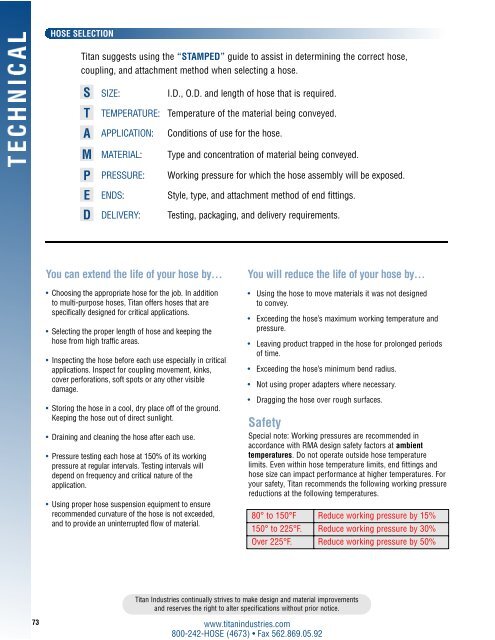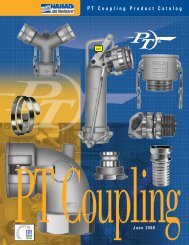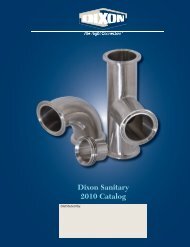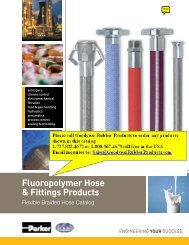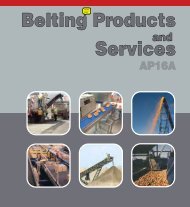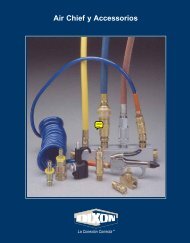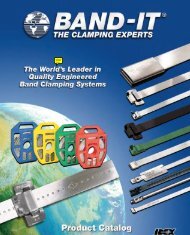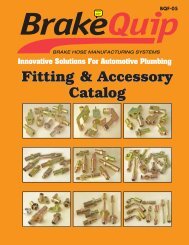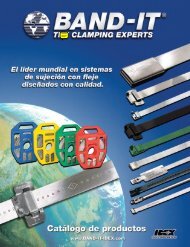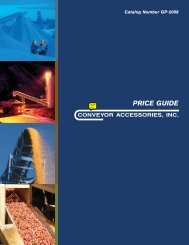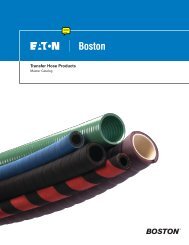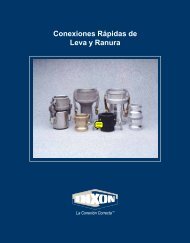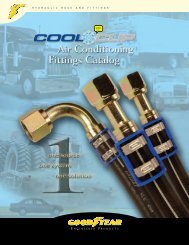Parker Titan Industrial Hose Division - Goodyear Rubber Products, Inc.
Parker Titan Industrial Hose Division - Goodyear Rubber Products, Inc.
Parker Titan Industrial Hose Division - Goodyear Rubber Products, Inc.
Create successful ePaper yourself
Turn your PDF publications into a flip-book with our unique Google optimized e-Paper software.
73<br />
HOSE SELECTION<br />
<strong>Titan</strong> suggests using the “STAMPED” guide to assist in determining the correct hose,<br />
coupling, and attachment method when selecting a hose.<br />
S<br />
T<br />
A<br />
M<br />
P<br />
E<br />
D<br />
S I Z E: I.D., O.D. and length of hose that is required.<br />
T E M P E R AT U R E: Temperature of the material being conveyed.<br />
A P P L I C AT I O N: Conditions of use for the hose.<br />
M AT E R I A L: Type and concentration of material being conveyed.<br />
P R E S S U R E: Working pressure for which the hose assembly will be exposed.<br />
E N D S: Style, type, and attachment method of end fittings.<br />
D E L I V E RY: Testing, packaging, and delivery requirements.<br />
You can extend the life of your hose by… You will reduce the life of your hose by…<br />
• Choosing the appropriate hose for the job. In addition<br />
to multi-purpose hoses, <strong>Titan</strong> offers hoses that are<br />
specifically designed for critical applications.<br />
• Selecting the proper length of hose and keeping the<br />
hose from high traffic areas.<br />
• Inspecting the hose before each use especially in critical<br />
applications. Inspect for coupling movement, kinks,<br />
cover perforations, soft spots or any other visible<br />
d a m a g e .<br />
• Storing the hose in a cool, dry place off of the ground.<br />
Keeping the hose out of direct sunlight.<br />
• Draining and cleaning the hose after each use.<br />
• Pressure testing each hose at 150% of its working<br />
pressure at regular intervals. Testing intervals will<br />
depend on frequency and critical nature of the<br />
a p p l i c a t i o n .<br />
• Using proper hose suspension equipment to ensure<br />
recommended curvature of the hose is not exceeded,<br />
and to provide an uninterrupted flow of material.<br />
• Using the hose to move materials it was not designed<br />
to convey.<br />
• Exceeding the hose’s maximum working temperature and<br />
pressure.<br />
• Leaving product trapped in the hose for prolonged periods<br />
of time.<br />
• Exceeding the hose’s minimum bend radius.<br />
• Not using proper adapters where necessary.<br />
• Dragging the hose over rough surfaces.<br />
Safety<br />
Special note: Working pressures are recommended in<br />
accordance with RMA design safety factors at ambient<br />
temperatures. Do not operate outside hose temperature<br />
limits. Even within hose temperature limits, end fittings and<br />
hose size can impact performance at higher temperatures. For<br />
your safety, <strong>Titan</strong> recommends the following working pressure<br />
reductions at the following temperatures.<br />
<strong>Titan</strong> Industries continually strives to make design and material improvements<br />
and reserves the right to alter specifications without prior notice.<br />
www.titanindustries.com<br />
800-242-HOSE (4673) • Fax 562.869.05.92<br />
80° to 150°F Reduce working pressure by 15%<br />
150° to 225°F. Reduce working pressure by 30%<br />
Over 225°F. Reduce working pressure by 50%


